87 F. high in the Twin Cities Monday.
80 F. average high on August 18.
83 F. high on August 18, 2013.
August 18 in Minnesota Weather History (source: MPX Twin Cities National Weather Service):
2007: Record 24-hour maximum rainfall of 15.10 inches set in Hokah, MN (Houston County). This 24-hour total contributed to the record monthly maximum rainfall of 23.86 inches that was set in Hokah during August of 2007
1980: Strong winds at Belle Plaine severely damage five planes.

Half a Summer
I think I have carpal tunnel syndrome from scratching my head 18 hours a day, my face frozen in a perplexed, puzzled expression. Because the weather draped over North America is still a long way from average.
According to Japan’s Meteorological Agency July was the second warmest on record, worldwide. But we’ve seen huge variations here in the USA, faint whispers of the polar vortex keeping the Upper Midwest and New England cooler than average, while the west continues to fry.
The Twin Cities have only seen two days above 90F. An easy summer, right? Meanwhile Portland, Oregon has endured 12 days of 90s and counting. The same (stuck) ridge of high pressure sparking historic drought in California is sparking record heat out west, and the largest Washington State wildfire on record.
We dry out a bit today and Wednesday before the next round storms rumble in by late week; highs near 90F Friday and Saturday. For Day 1 of the State Fair an early storm Thursday will leave behind dew points near 70F.
Friday looks hot and sweaty; low 90s possible Saturday before a cooler front arrives Sunday. Expect 60s & low 70s by Monday.
I guess we’re overdue for a mild case of the Dog Days.
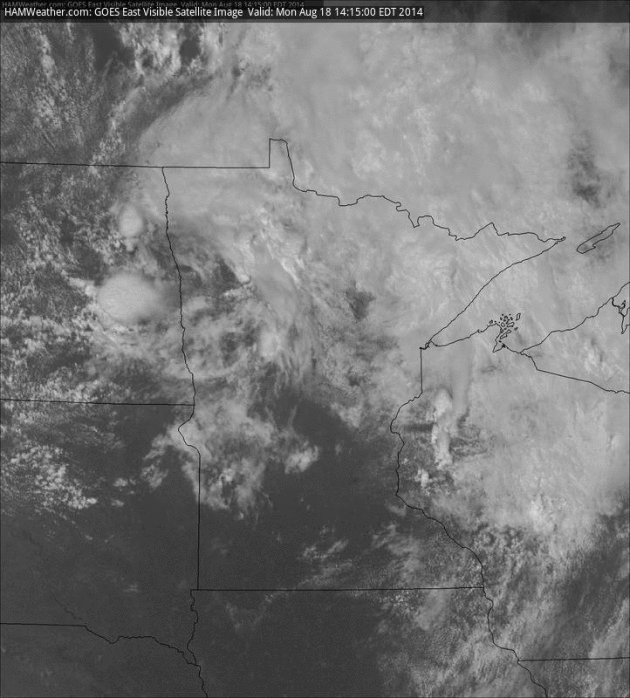
A Tropical Stew With Big Thundery Lumps. The atmosphere over Minnesota was volatile yesterday, dew points in the 60s with a pocket of chilly air overhead creating a very unstable airmass by mid afternoon. Wind shear wasn’t sufficient for widespread wind damage or tornadoes, but a few storms sparked quarter-size hail. The 1 KM visible loop during the afternoon shows cumulonimbus sprouting rapidly after 4 PM. Source: NOAA and HAMweather.

Outflow Boundaries. NWS Doppler at 6:47 PM Monday shows the most severe storms sprouting over far southern Minnesota, where a Severe Storm Watch was eventually issued. Look carefully and you can see outflow boundaries, arc-shaped swirls kicked off by rain and hail-cooled air spreading out on the ground, sparking more thunderstorms upwind. Source: GRLevel2.
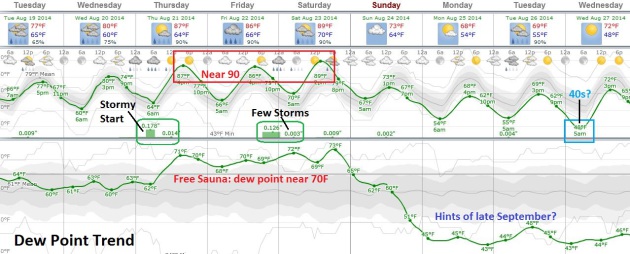
Dog Days, Then Football Weather. Long range guidance shows highs in the mid 80s to near 90F Thursday, Friday and Saturday, before a vigorous cool frontal passage arrives Saturday night; dew points droppping from low 70s Saturday into the low 40s by Monday. Storms are most likely early Thursday, late Friday and again late Saturday with the frontal passage. European models are hinting at 40s for lows by next Wednesday morning. MSP Meteograph: Weatherspark.

The News Behind The News: Furguson, Missouri Was Hit By an EF-4 Tornado in 2011. Here’s more information on the tornado strike, the biggest in St. Louis County in 44 years, on Palm Sunday, April 22, 2011, from the St. Louis National Weather Service: “Two tornadic supercells crossed the St. Louis County Warning Area during the afternoon and evening hours of Good Friday, April 22 2011. The northern most supercell spawned a EF4 tornado that ripped a 21 mile path of destruction across St. Louis County in Missouri and Madison County in Illinois. Municipalities that were affected include Maryland Heights, Bridgeton, St. Ann, Edmundson, Lambert St. Louis International Airport (City of St. Louis), Berkeley, Ferguson, Pontoon Beach/Granite City. Remarkably, there were no fatalities with this event. This can be attributed to the 34 minutes of tornado warning lead time, wall to wall media coverage, and the actions of those in the direct path of the tornado...” (Photo credit above: Jeff Robinson, AP).

So why mention the EF-4 that caused significant damage in Furguson 3 years ago? Larry Lazar, a friend and colleague who lives in St. Louis, provided the photos above and some context below: “I’m sure you have all seen and heard the disturbing news from Ferguson, Missouri over the last week or so. Ferguson is a suburb in the northern part of St. Louis (just east of the airport if you have been to St. Louis). What is not making the news is that Ferguson was devastated by a direct hit from a F4 tornado in the spring of 2011….It is likely a stretch to link the civil unrest in Ferguson to the devastation caused by tornadoes 3 years ago. However, when unprecedented weather disasters hit, the most pain and suffering frequently occurs in the those poor neighborhoods that are least equipped to deal with the impacts or the cleanup. Poor communities like Ferguson are often unable to fully recover from weather disasters, which exasperates other issues affecting the community. I participated for one day in a clean-up effort organized by the American Red Cross and took quite a few pictures. Here are a handful…”
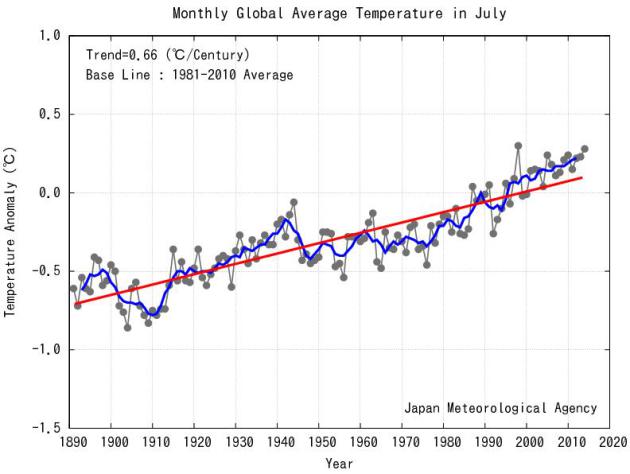
July: Second Warmest On Record, Worldwide? Here’s a graphic and excerpt of a post at the Japan Meteorological Agency: “The monthly anomaly of the global average surface temperature in July 2014 (i.e. the average of the near-surface air temperature over land and the SST) was +0.28°C above the 1981-2010 average (+0.63°C above the 20th century average), and was the 2nd warmest since 1891. On a longer time scale, global average surface temperatures have risen at a rate of about 0.66°C per century…”

West’s Historic Drought Stokes Fears of Water Crisis. Water in underground acquifers only goes so far, as people in California’s Central Valley are quickly discovering. Here’s a clip from The Washington Post: “…Now, across California’s vital agricultural belt, nervousness over the state’s epic drought has given way to alarm. Streams and lakes have long since shriveled up in many parts of the state, and now the aquifers — always a backup source during the region’s periodic droughts — are being pumped away at rates that scientists say are both historic and unsustainable. One state-owned well near Sacramento registered an astonishing 100-foot drop in three months as the water table, strained by new demand from farmers, homeowners and municipalities, sank to a record low...”
Photo credit: “Brandon Arthur, 10, tries to get out of muddy tailings left by his father Steve Arthur’s water well drill site on Juan Carrera’s orange grove farm in Terra Bella, Calif., on July 16, 2014. Arthur’s crew is drilling a well on Carrera’s farm that will provide water for his grove. River water and melted snow have dried up, forcing farmers like Carrera to drill newer and deeper wells to tap shrinking groundwater sources.” (Bob Chamberlin/Los Angeles Times/MCT).
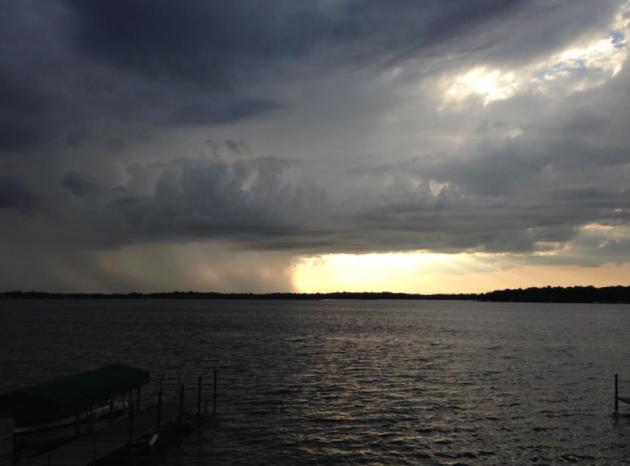
TODAY: Sunny, a bit less humid. Stray PM T-storm. Dew point: 63. Winds: NW 10+ High: 79
TUESDAY NIGHT: Mostly clear and relatively comfortable. Low: 59
WEDNESDAY: Plenty of sun, pleasant. High: 81
THURSDAY: Stormy start for the MN State Fair, sticky PM sun. DP: 70. Wake-up: 66. High: 86
FRIDAY: Steamy sun. Free sauna. Dew point: 71. Wake-up: 67. High: 88
SATURDAY: Still tropical and hot. Numerous T-storms north/west Minnesota. Dew point: 71. Wake-up: 71. High: 91
SUNDAY: More clouds than sun. Leftover shower; turning cooler. Wake-up: 68. High: 76
MONDAY: Fresh air, hints of September. Comfortable sun. DP: 45. Wake-up: 56. High: 72
Climate Stories…
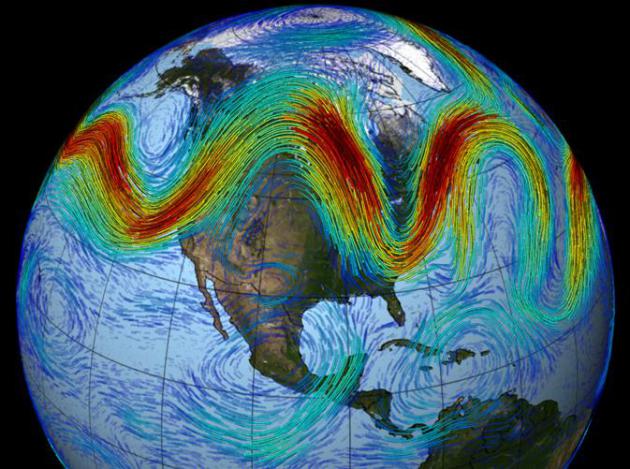
Recent Arctic Amplification and Extreme Mid-Latitude Weather. This is a trend I’ve been seeing on the weather maps, especially since 2010 or so; a tendency toward more elongated (amplifed) Rossby waves over the Northern Hemisphere, triggering a subsequent slow-down of weather patterns, more of a potential for weather to get stuck for days or weeks (the polar vortex last winter was in place for the better part of 3 months). Here’s an abstract of new research from Jennifer Francis (et all) at Nature Geoscience: “The Arctic region has warmed more than twice as fast as the global average — a phenomenon known as Arctic amplification. The rapid Arctic warming has contributed to dramatic melting of Arctic sea ice and spring snow cover, at a pace greater than that simulated by climate models. These profound changes to the Arctic system have coincided with a period of ostensibly more frequent extreme weather events across the Northern Hemisphere mid-latitudes, including severe winters. The possibility of a link between Arctic change and mid-latitude weather has spurred research activities that reveal three potential dynamical pathways linking Arctic amplification to mid-latitude weather: changes in storm tracks, the jet stream, and planetary waves and their associated energy propagation…”
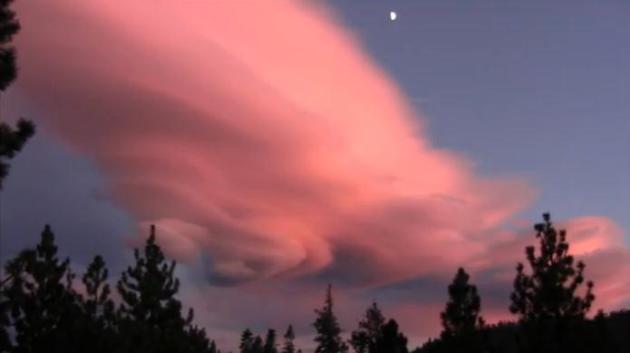
Real Conservatives are Conservationists. Here’s an excerpt of a story that resonated with me from Professor of Geological Sciences (and avowed conservative) Barry Bickmore, at heraldextra.com: “Why is it that some political conservatives have been so obstinate in opposing any government action to address human-caused climate change? The answer is that they aren’t real conservatives. Real conservatives favor working toward a truly free and equitable society by intelligently considering our options and choosing those that will cause the least social upheaval and loss of individual freedom. This minimalist approach to managing change stems from a healthy respect for “the Law of Unintended Consequences.” That is, whenever humans try to fix things, we always fail to account for all the consequences, which are often much worse than we expected. This is why conservatives, such as Edmund Burke, Teddy Roosevelt, Dwight Eisenhower, Barry Goldwater, and Richard Nixon, have historically also been conservationists…”

Communicating Climate Change – Without The Scary Monsters. Local. Local. Local. Here’s a clip from a story at RTCC.org that got my attention: “…Why worry about the potential to break the 2C barrier, when you have to pay the mortgage? Who’s buying the next round? Or (and this is tough) convince the kids they’ve watched too much of Peppa Pig for one day? It’s a question exercising Pete Bowyer, who heads up the climate arm of PR firm Havas, charged with promoting UN Secretary General Ban Ki-moon’s climate summit. “They say all politics is local – but all communications is local – and that’s particularly true of climate change, he tells RTCC...”
It’s a question exercising Pete Bowyer, who heads up the climate arm of PR firm Havas, charged with promoting UN secretary general Ban Ki-moon’s climate summit.
“They say all politics is local – but all communications is local – and that’s particularly true of climate change,” he tells RTCC.
– See more at: http://www.rtcc.org/2014/08/15/communicating-climate-change-without-the-scary-monsters/#sthash.RpUPRzgO.dpuf

MIT Study: Climate Talks on Path to Fall Far Short of Goals. Here’s an excerpt of an article at InsideClimateNews: “…Facing a deadline to reach a new treaty by the end of next year in Paris, the world’s nations seem unwilling to make the kind of pledges that would rein in global warming to safe levels by century’s end, the researchers concluded. “Our analysis concludes that these international efforts will indeed bend at the curve of global emissions” of carbon dioxide and other planet-warming greenhouse gases, they said. “However, our results also show that these efforts will not put the globe on a path consistent with commonly stated long-term climate goals...”

Water Scarcity and Climate Change Through 2095. Dry areas are, overall, becoming even drier, and access to fresh water will be a defining theme of the 21st century. Things we often took for granted we won’t be taking for granted in the years ahead. Just ask a friend living in California. Here’s a clip from phys.org: “…In a first of its kind comprehensive analysis, the researchers, working at the Joint Global Change Research Institute, used a unique modeling capability that links economic, energy, land-use and climate systems to show the effects of global change on water scarcity. When they incorporated water use and availability in this powerful engine and ran scenarios of possible climate mitigation policy targets, they found that without any climate policy to curb emissions, half the world will be living under extreme water scarcity…”

Media Gets It Wrong on Mann Suit. Chilling freedom of speech, or a blatant case of libel? Here’s one perspective at Daily Kos: “…As Greg Laden points out, the suit is not about scientific criticism, but rather “a very specific and actionable libelous accusation of professional misconduct.” Previous courts agreed that this is a valid case, that Steyn’s accusations of fraud and manipulation of data aren’t just opinion, but an (incorrect) statement of fact. Saying that a scientist is “the Jerry Sandusky of climate science” is an opinion, and not what Dr. Mann is suing over, even though Fox News suggests it is. Instead, the accusation that he “molested and tortured data” is clearly not an opinion on the man or the issue but a claim that many studies reaffirming Mann’s findings have shown to be false…”
Read more at: http://phys.org/news/2014-08-scarcity-climate.html#jCpMedia Gets It Wrong on Mann Suit. Chilling freedom of speech, or a blatant case of libel? Here’s one perspective at Daily Kos: “…As Greg Laden points out, the suit is not about scientific criticism, but rather “a very specific and actionable libelous accusation of professional misconduct.” Previous courts agreed that this is a valid case, that Steyn’s accusations of fraud and manipulation of data aren’t just opinion, but an (incorrect) statement of fact. Saying that a scientist is “the Jerry Sandusky of climate science” is an opinion, and not what Dr. Mann is suing over, even though Fox News suggests it is. Instead, the accusation that he “molested and tortured data” is clearly not an opinion on the man or the issue but a claim that many studies reaffirming Mann’s findings have shown to be false…”

Global Warming Rears It’s Ugly Head Around the World – In English. Here’s an excerpt from a story at The Guardian: “…However, many Republican politicians are currently frozen with fear on the subject of global warming. Specifically, fear of the Tea Party.
In stark contrast to their party’s public stance on Capitol Hill, many Republicans privately acknowledge the scientific consensus that human activity is at least partially responsible for climate change and recognize the need to address the problem … In Bloomberg BNA interviews with several dozen former senior congressional aides, nongovernmental organizations, lobbyists and others conducted over a period of several months, the sources cited fears of attracting an electoral primary challenger as one of the main reasons many Republicans choose not to speak out.

